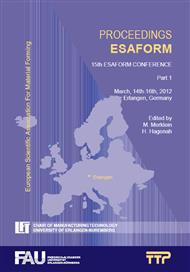p.17
p.23
p.29
p.35
p.41
p.47
p.53
p.59
p.65
Modelling of Strain Hardening Behaviour of Sheet Metals for Stochastic Simulations
Abstract:
In current forming simulations, Ghosh or Hockett-Sherby extrapolation functions are used to model strain hardening effects of sheet metals. When it comes to stochastic simulations, the respective parameters have to be recalculated according to the scattering of the mechanical material properties like yield or tensile strength. As present stochastic samplings for deep drawing simulations only consider yield strength and tensile strength, it is non-trivial securing the extrapolated area of strain hardening curves due to lack of data beyond uniform strain. It is current practice to improve the description of the flow curve beyond uniform elongation point by using the maximum force criterion, which takes into account the gradient of the yield curve at the last known point. The corresponding system of equations has to be solved numerically. We propose a method for adjusting parameters of the Ghosh or Hockett-Sherby extrapolation functions, which overcomes the need of numerical calculations and keeps flow curve information from the extrapolated interval, even if the stochastic sampling doesn’t incorporate any data regarding that area.
Info:
Periodical:
Pages:
41-46
Citation:
Online since:
February 2012
Authors:
Price:
Сopyright:
© 2012 Trans Tech Publications Ltd. All Rights Reserved
Share:
Citation:


